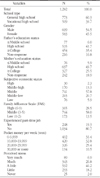Abstract
Objectives
The principle purpose of this study was to investigate the differences of oral health-related behaviors by a type of school among high school students in Gangneung city. The secondary purpose was to assess the influences of other factors (father's education status, mother's education status, subjective economic status, FAS, experienced part-time job, pocket money and perceived stress) on these differences.
Methods
A cross-sectional survey of 1,282 high school students was conducted in Gangneung city. The response rate was 93.4%; general high school students were 773 and vocational high school students were 509. The data were collected by self-administered structured questionnaires. The differences of oral health-related behaviors of high school students by school type were assessed by a chisquare test. Logistic regression models were used to analyze the influences of other factors on these differences.
Results
Oral health-related behaviors were markedly better in students attending general high school, rather than vocational high school (P<0.001). The differences of oral health-related behaviors by school type were persisted after adjusting for gender (Model 1), socio-economic factors (Model 2), part-time job and pocket money (Model 3), psychological variables (Model 4) and all variables (Model 5), except for visiting a dental clinic.
Conclusions
We found a marked influence of school type in oral health-related behaviors. This finding suggests that school type is a risk factor of oral health-related behaviors in high school students. Therefore, one of the best ways to enhance oral health for high school students is to develop oral health promotion programs for vocational high school students.
Figures and Tables
Table 3
Distribution of oral health-related behaviors of high school students in Gangneung city by school type

Table 4
Odds ratios for the association between oral health-related behaviors and high school type using multiple logistic regression analysis

*P<0.05, †P<0.01, ‡P<0.001.
Model 1: adjusting for gender.
Model 2: adjusting for gender, father's education status, mother's education status, subjective economic status and FAS (Family Affluence Scale).
Model 3: adjusting for gender, experienced part-time job and pocket money.
Model 4: adjusting for gender and perceived stress.
Model 5: adjusting for gender, father's education status, mother's education status, subjective economic status, FAS (Family Affluence Scale), experienced part-time job, pocket money and perceived stress.
References
1. Hwang MH, Kim BW, Choi IJ, Heo EY. Exploring career development of Korean adolescents. Asian J Educ. 2010. 11:75–94.

2. Hwang MS, Jo HS. The relationship between developmental assets for young people and health risk behaviors. Korean J Health Psychol. 2004. 9:85–98.
3. Daly B, Watt R, Batchelor P, Treasure E. Essential Dental Public Health. 2002. UK: Oxford;21–32.
4. Shin SJ, Ahn YS, Jung SH. The relation between dental health behaviors and socioeconomic status among Korean adolescents. J Korean Acad Oral Health. 2008. 32:223–230.
5. Wardle J, Jarvis MJ, Steggles N, Sutton S, Williamson S, Farrimond H, et al. Socioeconomic disparities in cancer-risk behaviors in adolescence: baseline results from the Health and Behaviour in Teenagers Study (HABITS). Prev Med. 2003. 36:721–730.

6. Noh HJ, Choi CH, Sohn WS. The relationship between oral health behavior and frequency of oral health education in adolescent. J Korean Acad Oral Health. 2008. 32:203–213.
7. Hwang JM, Seong JM, Kim JH, Yoo SM, Park YD. The relationship between oral health behaviors and sociodemographic characteristics in Korean adolescents. J Korean Acad Oral Health. 2009. 33:367–376.
8. Jung SH, Tsakos G, Sheiham A, Ryu JI, Watt RG. Socioeconomic status and oral health-related behaviours in Korean adolescents. Soc Sci Med. 2010. 70:1780–1788.

9. Petersen PE, Jiang H, Peng B, Tai BJ, Bian Z. Oral and general health behaviours among Chinese urban adolescents. Community Dent Oral Epidemiol. 2008. 36:76–84.

10. Jiang H, Petersen PE, Peng B, Tai B, Bian Z. Self-assessed dental health, oral health practices, and general health behaviours in Chinese urban adolescents. Acta Odontol Scand. 2005. 63:343–352.

11. Berndt TJ, Keefe K. Friends' influence of adolescents' adjustment to school. Child Dev. 1995. 66:1312–1329.
12. Dekovié M, Meeus W. Peer relations in adolescents: effects of parenting and adolescents' self-concept. J Adolesc. 1997. 20:163–176.
13. Richter M, Leppin A. Trends in socio-economic differences in tobacco smoking among German schoolchildren, 1994-2002. Eur J Public Health. 2007. 17:565–571.

14. Aarnio M, Kujala UM, Kaprio J. Associations of health-related behaviors, school type and health status to physical activity patterns in 16 year old boys and girls. Scand J Soc Med. 1997. 25:156–167.

15. Ju DB. The analysis of differences in high school students' educational outcomes by high school track. J Vocat Educ Res. 2010. 29:1–15.
16. Kim JG. Differential career in high school and social inequality. J Educ Res. 1995. 13:65–105.
17. Ministry of Health & Welfare. 2009 Korea Youth Risk Behavior Web-based Survey. 2009. Seoul: Ministry of Health & Welfare;47–239.
18. Moynihan P, Petersen PE. Diet, nutrition and the prevention of dental diseases. Public Health Nutr. 2004. 7:201–226.

19. Sussman S, Dent CW, Stacy AW, Burciaga C, Raynor A, Turner GE, et al. Peer-group association and adolescent tobacco use. J Abnorm Psychol. 1990. 99:349–352.

20. Rudatsikira E, Muula A, Siziya S. Current cigarette smoking among in school American youth: results from the 2004 National Youth Tobacco Survey. Int J Equity Health. 2009. 8:1–9.




 PDF
PDF ePub
ePub Citation
Citation Print
Print




 XML Download
XML Download